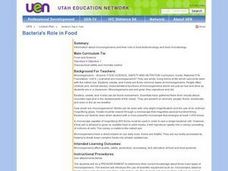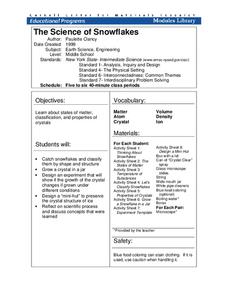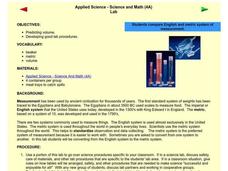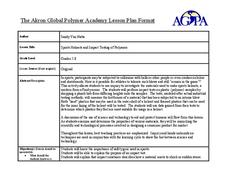Curated OER
Measuring Calories in Food
Learners measure the amount of calories in food. In this food energy lesson, students discuss what a calorie is, how our bodies use a calorie, and how many we need. Then, learners use a calorimeter to calculate the amount of energy in a...
Curated OER
Bacteria's Role in Food
Young scholars grow bacteria cultures on agar in petri dishes and do a plate count. They participate in a yogurt making lab to see how bacteria produce lactic acid. They prepare a recipe and identify fungi, fermentation and the role of...
Curated OER
Food Pyramid Lab
Third graders complete a lab to review the Food Guide Pyramid and prepare a food item using all of the food groups.
Cornell University
The Science of Snowflakes
Who can grow the best crystals? Challenge class members to develop strategies for enhancing growth in the crystals. Through a lab investigation, learners study the properties of crystals and test the effectiveness of different growth...
Curated OER
What Are You Eating?
Discover the calorie content of foods by observing how much heat they produce in water. If you have a calculator-based laboratory (CBL™) insturment for collecting data, then this laboratory worksheet will not need any changes. If not,...
Curated OER
Kitchen Equip and Lab Procedures - Level I
Students, in groups, record at least four pieces of equipment that fit a specified category as well as a safety tip to observe when using the equipment.
Curated OER
The Dangers of Being Obese/Overweight
Third graders determine if they are eating healthy. For this healthy living lesson, 3rd graders watch a video titled Happy Health and review the food pyramid. Students create a spreadsheet where they list their food intake for the week...
Curated OER
The Balance of Good Health and the Food Pyramid
Students explore the importance of good health and the food pyramid. They examine food labels and the importance of healthy food choices. Students investigate food additives.
Curated OER
Burning Snacks in Chem Lab
Students determine the energy content of various snack foods. They measure the temperature changes in various snack foods as the foods are burned in order to determine the foods' energy content. Students create graphs and data tables of...
Curated OER
Helpful Microorganisms
Students study how some microorganisms are helpful and practical in foods. They work with microorganism in a number of food, such as yeast in bread and yogurt.
Curated OER
Genetically Modified Foods
High schoolers explain what genetically modified foods are and how they are created. Students use appropriate vocabulary to describe and effectively discuss the benefits of, and potential risks of, genetically modified foods.
University of Georgia
Density and Texture of Soil
All soil is not created equal! A lab activity asks learners to collect and analyze soil. Specific calculations determine the amount of sand, silt, and clay in a sample and allow individuals to identify the soil texture.
Curated OER
Safe and Sanitary Work Habits - Level 1
Students brainstorm hazards in the kitchen, and categorize them. They develop a checklist that could be used by an inspector to evaluate a home economics foods laboratory. They create a recipe while using proper lab and safety procedures.
Curated OER
Applied Science - Science and Math Lab
Although it was written to use in a science class, this measurement lesson is adaptable to Common Core standards in math for measurement and data. Youngsters are introduced to two types of measurement systems. They use both the English...
Curated OER
Soil Nutrients - Phosphorus Lab Lesson Plan
Students list sources of phosphorus in soil. They explain how phosphorus is removed from the soil and used by plants. Students list the symptoms of insufficient or excess phosphorus. Students perform experiments to examine the effect of...
Curated OER
Semipermeable Membranes and Bioaccumulation
Beginning biologists place a drop of food coloring into water of differing temperatures to observe the effect on the diffusion rate. They remove the shells from raw eggs and then experiment with osmosis over the remaining membranes....
Curated OER
Exploring Ecology
Students explore the basics of ecology through numerous hands-on and relevant activities. They participate in an online food chain demonstration, which explores food web dynamics. They dissect owl pellets, examine the prey's bones, and...
Curated OER
Microwave Introduction
Young scholars take true and false pretest, and explore and practice basic principles of microwave cooking and how to use and care for it properly while preparing foods. Students watch teacher demonstration and then prepare their own...
Curated OER
Ground Beef Lab - Open-Faced Tacos
Students will use ingredients and read a recipe to create open faced tacos. The emphasis of the lesson is the kind of preparation that is needed to cook ground beef correctly to avoid diseases associated with improper preparation...
University of Georgia
Monohybrid Crosses and The Punnett Square Lesson Plan
Looking for a quick, hands-on activity to teach young scientists about Punnett squares through monohybrid crosses? then check out this one.
Curated OER
Foods--Pretest
Students identify the steps in washing dishes by placing them in the correct order by from number 1 to 7 in front of each step. Then, they identify various cooking terms and define each one. Finally, students write the correct...
Curated OER
How Sweet It is! A Colorful Sugar Solution Density Column
Students examine the affect of density. Using a graduated cylinder and equally prepared volumes of sugar-water solutions and food color, students observe a sugar rainbow. They discover that the greater the amount of sugar in the...
Curated OER
Stoichiometry
Young scholars discover stoichiometric relationships in chemical equations. They review mole to mole conversions. They understand mass/particle conversions. They perform a lab to reinforce stoichiometry.
Curated OER
Sports Helmets and Impact Testing of Polymers
Students examine the importance of good quality safety gear. In this investigative instructional activity, students will tests various polymers, collect data, and analyze the data to determine which polymer is best for safety helmets....

























